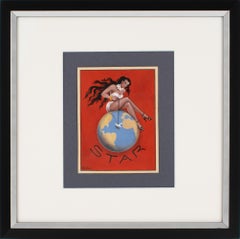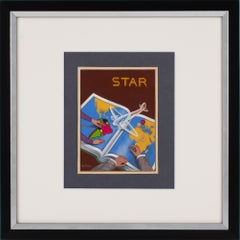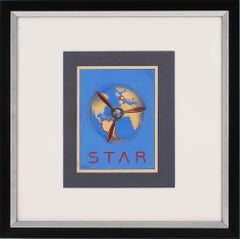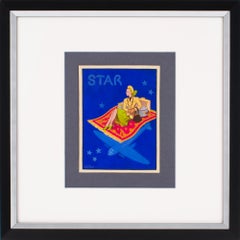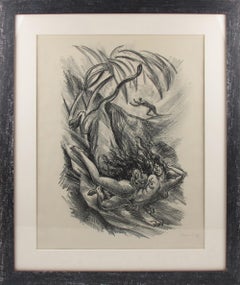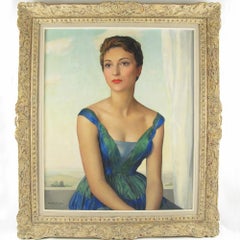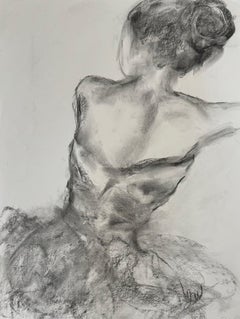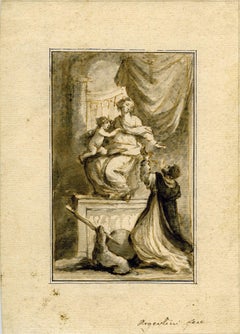BLUE IRIS / IRIS BLEU Figurative Paintings
to
4
2
2
1
Overall Width
to
Overall Height
to
9
1
1
4
1
1
4
4
1
5
3
1
5
4
1
1
1
1
1
1
1
4
4
4
4
3
1
9
9
French Illustration Aviation Poster Project Gouache Drawing by C. Villars
Located in Atlanta, GA
This is a rare, original Post-war illustration drawing, hand-painted with gouache on Arches Velin paper by French artist C. Villars (France, 20th Century). The poster project feature...
Category
1940s Post-War Portrait Drawings and Watercolors
Materials
Paper
French Poster Study Aviation Illustration Gouache Drawing by C. Villars
Located in Atlanta, GA
This is a rare original Post-war illustration drawing, hand-painted with gouache on Arches Velum paper by French artist C. Villars (France, 20th Century). The modernist composition s...
Category
1940s Post-War Portrait Drawings and Watercolors
Materials
Paper
French Aviation Illustration Poster Study Gouache Drawing by C. Villars
Located in Atlanta, GA
Original Post-War Airline Illustration by C. Villars (France, 20th Century) — Gouache on Arches Velin Paper.
This rare, original Post-war illustration drawing was hand-painted with g...
Category
1940s Post-War Portrait Drawings and Watercolors
Materials
Paper, Gouache
Gouache Drawing Aviation Airline Study by C. Villars
Located in Atlanta, GA
Post-War Airline Illustration by C. Villars (France, 20th Century) — Gouache on Arches Velin Paper.
This rare, original post-war gouache illustration was hand-painted by French artis...
Category
1940s Post-War Portrait Drawings and Watercolors
Materials
Paper
Art Deco Fantasy Charcoal Drawing Lithograph Print by Adolf Uzarski
Located in Atlanta, GA
This stunning charcoal drawing lithograph print on paper depicting a fanciful lion kidnapping a young woman was designed by Adolf Uzarski (1885-1970), a German artist. This drawing i...
Category
1910s Art Deco Figurative Drawings and Watercolors
Materials
Charcoal
The Blue Dress Young Woman Oil on Canvas Painting by Maurice Ehlinger
By Maurice Ambroise Ehlinger
Located in Atlanta, GA
Maurice Ambroise Ehlinger (1896–1981) — Portrait of Mademoiselle France Noël, 1957. Radiating timeless Parisian elegance, this exceptional mid-century oil on canvas by noted French p...
Category
1950s Modern Portrait Paintings
Materials
Canvas
Brooklyn Transfer East River Crossing, Oil on Canvas Painting Frederick Reimers
Located in Atlanta, GA
"Bklyn Transfer, East River Crossing" by Frederick Reimers (1911–1994)
This unique, captivating cityscape painting by Frederick Reimers (USA, 1911–1994) offers a dynamic view of the ...
Category
20th Century Modern Landscape Paintings
Materials
Canvas, Oil, Acrylic
Street View in France, Oil on Canvas Painting by Renzo Gori
Located in Atlanta, GA
Italian artist Renzo Gori (1911 - 1998) designed this oil on canvas painting which features an animated urban street scene in France. The artist's signature is in the bottom right co...
Category
1930s Modern Landscape Paintings
Materials
Canvas, Oil
Important Still Life Oil on Canvas Painting, Centerpiece Bowl with Fruits
Located in Atlanta, GA
This stunning oil on canvas painting of a highly colorful still-life composition features a fruit bowl with fruits and grapes.
It is an extremely lively and vibrant post-cubist exec...
Category
1980s Modern Figurative Paintings
Materials
Canvas, Oil
Related Items
Posing for the Artist by Judith Williams black and white ballerina on paper
By Judith Williams
Located in Atlanta, GA
"The unusual shapes coming together in their raw simplistic form, how they interact with each other, the shapes creating their own language. I let them stand alone in their purest fo...
Category
2010s Contemporary Figurative Paintings
Materials
Paper, Charcoal, Mixed Media
$800
H 24 in W 18 in D 2 in
Neoclassical composition of a sculptor kneeling before his statue of the Madonna
Located in Middletown, NY
An allegory of loyalty, with the subject's dog pictured seated, holding his master's chisel in his mouth; fidelity personified.
Italian School, 18th century
Ink wash in gray and bl...
Category
Mid-18th Century Italian School Figurative Paintings
Materials
Laid Paper, Ink, Watercolor
$500
H 9.73 in W 7.01 in
Interior with Five Children - Oil Painting on Canvas - 19th Century
Located in Roma, IT
Interior with Five Children is an original oil painting on canvas applied on panel.
This painting has been realized between the end of the 19th century ...
Category
19th Century Modern Figurative Paintings
Materials
Canvas, Oil
$1,068
H 15.75 in W 11.82 in D 1.19 in
Side Show Barker - Original Modernist American Fair Scene Oil Painting
Located in Marco Island, FL
From the Michael Hall Collection, this is a great American scene showing the excitement of the fair. It depicts a time when men wore coats and ties and women had hats at the fair be...
Category
1930s American Modern Figurative Paintings
Materials
Canvas, Oil
$36,000
H 32 in W 37 in D 3 in
Ballerina - Oil Paint by Miroslava Vrbová-Štefková - mid-20th Century
Located in Roma, IT
Dancer is a beautiful oil on panel realized by Vrbová-Štefková in the mid-20th Century.
Signed and framed, 60 x 50 cm.
Good condition.
Category
Mid-20th Century Modern Figurative Paintings
Materials
Canvas, Oil
$2,874
H 23.63 in W 19.69 in D 1.97 in
Rare Modernist Hungarian Rabbi Pastel Drawing Gouache Painting Judaica Art Deco
By Hugó Scheiber
Located in Surfside, FL
Rabbi in the synagogue at prayer wearing tallit and tefillin.
Hugó Scheiber (born 29 September 1873 in Budapest – died there 7 March 1950) was a Hungarian modernist painter.
Hugo Scheiber was brought from Budapest to Vienna at the age of eight where his father worked as a sign painter for the Prater Theater. At fifteen, he returned with his family to Budapest and began working during the day to help support them and attending painting classes at the School of Design in the evening, where Henrik Papp was one of his teachers. He completed his studies in 1900. His work was at first in a post-Impressionistic style but from 1910 onward showed his increasing interest in German Expressionism and Futurism. This made it of little interest to the conservative Hungarian art establishment.
However, in 1915 he met the great Italian avant-gardist Filippo Tommaso Marinetti and the two painters became close friends. Marinetti invited him to join the Futurist Movement. The uniquely modernist style that he developed was, however, closer to German Expressionism than to Futurism and eventually drifted toward an international art deco manner similar to Erté's. In 1919, he and his friend Béla Kádar held an exhibition at the Hevesy Salon in Vienna. It was a great success and at last caused the Budapest Art Museum to acquire some of Scheiber's drawings. Encouraged, Scheiber came back to live in Vienna in 1920.
A turning point in Scheiber's career came a year later, when Herwarth Walden, founder of Germany's leading avant-garde periodical, Der Sturm, and of the Sturm Gallery in Berlin, became interested in Scheiber's work. Scheiber moved to Berlin in 1922, and his paintings soon appeared regularly in Walden's magazine and elsewhere. Exhibitions of his work followed in London, Rome, La Paz, and New York.
Scheiber's move to Germany coincided with a significant exodus of Hungarian artists to Berlin, including Laszlo Moholy-Nagy and Sandor Bortnyik. There had been a major split in ideology among the Hungarian avant-garde. The Constructivist and leader of the Hungarian avantgarde, Lajos Kassák (painted by Hugó Scheiber in 1930) believed that art should relate to all the needs of contemporary humankind. Thus he refused to compromise the purity of his style to reflect the demands of either the ruling class or socialists and communists. The other camp believed that an artist should be a figurehead for social and political change.
The fall out and factions that resulted from this politicisation resulted in most of the Hungarian avant gardists leaving Vienna for Berlin. Hungarian émigrés made up one of the largest minority groups in the German capital and the influx of their painters had a significant effect on Hungarian and international art. Another turning point of Scheiber's career came in 1926, with the New York exhibition of the Société Anonyme, organized by Katherine Dreier. Scheiber and other important avant garde artists from more than twenty-three countries were represented. In 1933, Scheiber was invited by Marinetti to participate in the great meeting of the Futurists held in Rome in late April 1933, Mostra Nazionale d’Arte Futurista where he was received with great enthusiasm. Gradually, the Hungarian artists began to return home, particularly with the rise of Nazism in Germany. Kádar went back from Berlin in about 1932 and Scheiber followed in 1934.
He was then at the peak of his powers and had a special flair in depicting café and cabaret life in vivid colors, sturdily abstracted forms and spontaneous brush strokes. Scheiber depicted cosmopolitan modern life using stylized shapes and expressive colors. His preferred subjects were cabaret and street scenes, jazz musicians, flappers, and a series of self-portraits (usually with a cigar). his principal media being gouache and oil. He was a member of the prestigious New Society of Artists (KUT—Képzőművészek Új Társasága)and seems to have weathered Hungary's post–World War II transition to state-communism without difficulty. He continued to be well regarded, eventually even receiving the posthumous honor of having one of his images used for a Russian Soviet postage stamp (see image above). Hugó Scheiber died in Budapest in 1950.
Paintings by Hugó Scheiber form part of permanent museum collections in Budapest (Hungarian National Museum), Pecs (Jannus Pannonius Museum), Vienna, New York, Bern and elsewhere. His work has also been shown in many important exhibitions, including:
"The Nell Walden Collection," Kunsthaus Zürich (1945)
"Collection of the Société Anonyme," Yale University Art Gallery, New Haven, Connecticut (1950)
"Hugó Scheiber: A Commemorative Exhibition," Hungarian National Museum, Budapest (1964)
"Ungarische Avantgarde," Galleria del Levante, Munich (1971)
"Paris-Berlin 1900-1930," Centre Georges Pompidou, Paris (1978)
"L’Art en Hongrie, 1905-1920," Musée d’Art et l’Industrie, Saint-Etienne (1980)
"Ungarische Avantgarde in der Weimarer Republik," Marburg (1986)
"Modernizmus," Eresz & Maklary Gallery, Budapest (2006)
"Hugó Scheiber & Béla Kádár," Galerie le Minotaure, Paris and Tel Aviv (2007)
Hugó Scheiber's paintings continue to be regularly sold at Sotheby's, Christie's, Gillen's Arts (London), Papillon Gallery (Los Angeles) and other auction houses.
He was included in the exhibition The Art Of Modern Hungary 1931 and other exhibitions along with Vilmos Novak Aba, Count Julius Batthyany, Pal Bor, Bela Buky, Denes Csanky, Istvan Csok, Bela Czobel, Peter Di Gabor, Bela Ivanyi Grunwald, Baron Ferenc Hatvany, Lipot Herman, Odon Marffy, C. Pal Molnar...
Category
Early 20th Century Modern Figurative Paintings
Materials
Paper, Charcoal, Pastel, Watercolor, Gouache
$5,500
H 15.75 in W 14.5 in
Drawing 14, Series Drawing - Large Format, Charcoal On Paper Panting
By Krzysztof Gliszczyński
Located in Salzburg, AT
The artwork is unframed and will be shipped rolled in a tube
Krzysztof Gliszczyński is Professor for painting on Academy of fine arts Gdansk.
Krzysztof Gliszczyński born in Miastko in 1962. Graduated from the Gdańsk Academy of Fine Arts in 1987 in the studio of Prof. Kazimierz Ostrowski. Between 1995 and 2002 founder and co-manager of Koło Gallery in Gdańsk. lnitiator of the Kazimierz Ostrowski Award, con-ferred by the Union of Polish Artists and Designers (ZPAP), Gdańsk Chapter. Dean of the Painting Faculty of the Gdańsk Academy of Fine Arts in the years 2008-2012. Vice Rector for Development and Cooperation of the Gdańsk Academy of Fine Arts in the years 2012-2016. Obtained a professorship in 2011. Currently head of the Third Painting Studio of the Painting Faculty of the Gdańsk Academy of Fine Arts. He has taken part in a few dozen exhibitions in Poland and abroad. He has received countless prizes and awards for his artistic work. He is active in the field of painting, drawing, objects, and video.
Artist Statement
In the 1990s I started collecting flakes of paint – leftovers from my work. I would put fresh ones in wooden formworks, dried ones in glass containers. They constituted layers of investigations into the field of painting, enclosed in dated and numbered cuboids measuring 47 × 10.5 × 10.5 cm. I called those objects Urns. In 2016, I displayed them at an exhibition, moulding a single object out of all the Urns. The Urns inspired me to redefine the status of my work as a painter. In order to do it, I performed a daunting task of placing the layers of paint not in an urn, but on a canvas, pressing each fresh bit of paint with my thumb. In the cycle of paintings Autoportret a’retour, the matter was transferred from painting to painting, expanding the area of each consecutive one. Together, the bits, the residua of paint, kept alive the memory of the previous works. It was a stage of the atomization of the painting matter and its alienation from the traditional concepts and aesthetic relations. Thus, the cycle of synergic paintings was created, as I called them, guided by the feeling evoked in me by the mutually intensifying flakes of paint. The final aesthetic result of the refining of the digested matter was a consequence of the automatism of the process of layering, thumb-pressing, and scraping off again. Just like in an archaeological excavation, attempts are made to unite and retrieve that which has been lost. This avant-garde concept consists in transferring into the area of painting of matter, virtually degraded and not belonging to the realm of art. And yet the matter re-enters it, acquiring a new meaning. The matter I created, building up like lava, became my new technique. I called it perpetuum pictura – self-perpetuated painting. Alchemical concepts allowed me to identify the process inherent in the emerging matter, to give it direction and meaning. In a way, I created matter which was introducing me into the pre-symbolic world – a world before form, unnamed. From this painterly magma, ideas sprung up, old theories of colour and the convoluted problem of squaring the circle manifested themselves again. Just like Harriot’s crystal refracted light in 1605, I tried to break up colour in the painting Iosis. Paintings were becoming symptoms, like in the work Pulp fiction, which at that time was a gesture of total fragmentation of matter and of transcending its boundaries, my dialogue with the works of Jackson Pollock and the freedom brought by his art. The painting Geometrica de physiologiam pictura contains a diagram in which I enter four colours that constitute an introduction to protopsychology, alchemical transmutation, and the ancient theory of colour. It this work I managed to present the identification of the essence of human physiology with art. But the essential aspect of my considerations in my most recent paintings is the analysis of abstraction, the study of its significance for the contemporary language of art and the search for the possibilities of creating a new message. For me, abstraction is not an end in itself, catering to the largely predicable expectations of the viewers. To study the boundary between visibility and invisibility, like in the work Unsichtbar, is to ask about the status of the possibilities of the language of abstraction. The moment of fluidity which I am able to attain results from the matter – matter...
Category
Early 2000s Conceptual Figurative Drawings and Watercolors
Materials
Paper, Charcoal
$2,994
H 78.75 in W 59.06 in
Feeling Sassy by Judith Williams black and white nude on paper
By Judith Williams
Located in Atlanta, GA
"The unusual shapes coming together in their raw simplistic form, how they interact with each other, the shapes creating their own language. I let them stand alone in their purest fo...
Category
2010s Contemporary Figurative Paintings
Materials
Paper, Charcoal, Mixed Media
$800
H 24 in W 18 in D 2 in
Drawing 13, Series Drawing - Large Format, Charcoal On Paper Panting
By Krzysztof Gliszczyński
Located in Salzburg, AT
The artwork is unframed and will be shipped rolled in a tube
Krzysztof Gliszczyński is Professor for painting on Academy of fine arts Gdansk. ...
Category
Early 2000s Conceptual Figurative Drawings and Watercolors
Materials
Paper, Charcoal
$2,994
H 78.75 in W 59.06 in
The Cyclists Rest Stop in Honfleur
Located in London, GB
'The Cyclists Rest Stop in Honfleur' by Jean-Marie Luc Blanpain, oil on canvas (circa 1970s). The artist's depiction of the terrace of the well known Honfleur restaurant, 'Au Relais ...
Category
1970s Modern Portrait Paintings
Materials
Canvas, Oil
$1,376 Sale Price
20% Off
H 16.93 in W 13.78 in
Timeless Beauty by Judith Williams black and white nude on paper
By Judith Williams
Located in Atlanta, GA
"The unusual shapes coming together in their raw simplistic form, how they interact with each other, the shapes creating their own language. I let them stand alone in their purest fo...
Category
2010s Contemporary Figurative Paintings
Materials
Paper, Charcoal, Mixed Media
$800
H 24 in W 18 in D 2 in
Frank Brangwyn Painting Mural Study Christ's Hospital West Horsham England 1912
By Sir Frank Brangwyn
Located in Portland, OR
FRANK BRANGWYN ( U.S./U.K./Belgium, 1867-1956) watercolor, gouache, and charcoal on paper, "The Scourging of St. Alban," study for the mural painted for Christ's Hospital, West Horsh...
Category
1910s Art Nouveau Figurative Paintings
Materials
Chalk, Charcoal, Watercolor, Gouache, Pencil
$7,500
H 21 in W 28 in D 1 in
